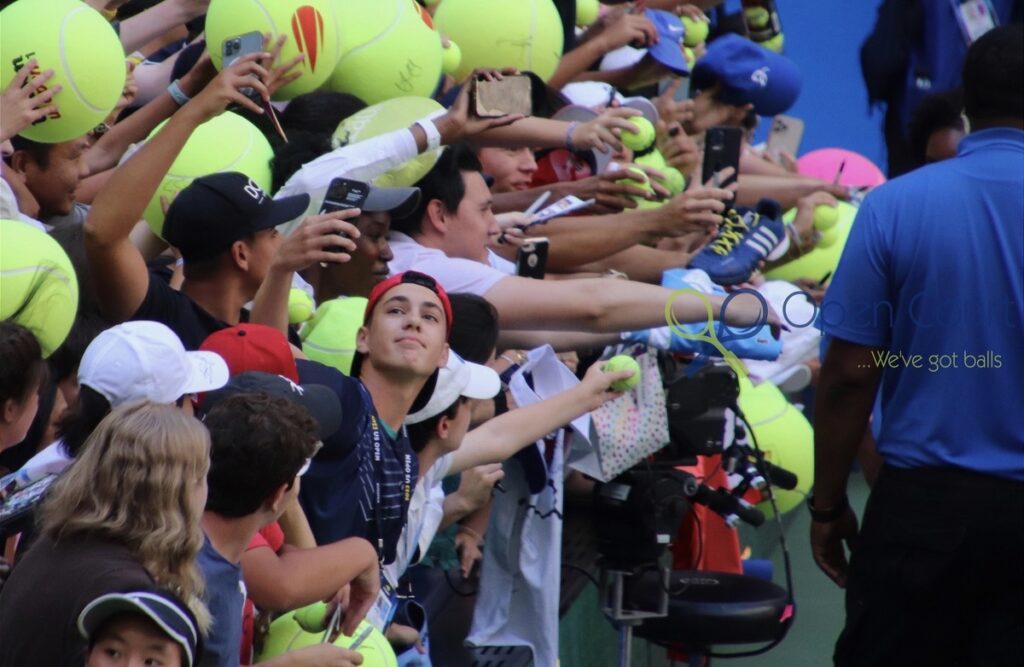
–
If you haven’t been connecting the dots – or are too distracted by the almost exclusively-online chatter about doping suspensions and whatnot – there’s a wholesale revolution happening in tennis that’s hiding in plain sight.
The tournaments are getting lengthier. And richer. And greedier. And the benefits seem to accrue only to the biggest events, the tournament owners and the already-wealthy top players.
So far, the spoils are mostly going to the already hugely profitable Grand Slam tournaments, which seem to like nothing more than competing (with each other) to be the richest, the longest, the most-attended – and the most congested.
As someone who’s been privileged to cover the majors for the last 16-17 years, I’ve observed this evolution up close in a way that the fans watching at home, or those only lucky enough to attend one of them, might not see. And it’s not that I’m against change and progress and growth – far from it. But it’s reaching a tipping point.
The big question to be asked is this: how big is TOO big?
Who’s paying the price? The players – rich and poor alike – and the paying customers. Not the high-income ones; the regular joes.
(We’re leaving Wimbledon out of this deep dive because its qualifying is still offsite and quaint, and the players still have peace as they prep for the big show. But if they get their way with the land they want to buy across the road from the All-England Club, they’ll join the chat).
There are so many elements to this, it’s hard to know where to begin. But let’s start with the farce that is now the mixed doubles at the US Open.
Unintended or disregarded consequences
The transformation of a competition that has been in existence for 140 years into … just another piece of fluffy content to fill out a extra week of a major, is emblematic of the seismic shift.
And we don’t even know yet if this ACTUAL Grand Slam competitive event will be included in the grounds pass, or there will an extra added charge for the privilege. The fact that they haven’t yet specified this is probably not a good sign.
The USTA is trying to sell this as being “good for the sport”, and “good for doubles”. Not sure who’s buying that one.
We wouldn’t presume to think the muckety-mucks at the USTA haven’t considered all of the consequences on the sport, or haven’t consulted people who … might have told them. Although several players have already confirmed that the players certainly weren’t consulted.
But the consequences, on so many levels, are such that you have to think they just don’t care. They’re securing their own bag, and they don’t care what anyone – especially those doubles players – think.
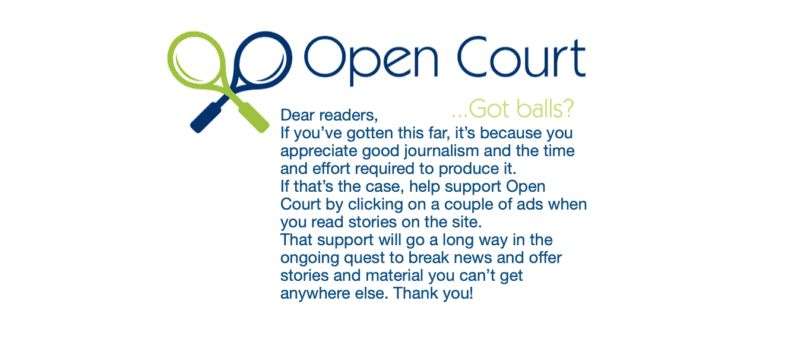
This change continues the evolution of Grand Slam tournaments from action-packed two-week events into … infernal, eternal three-week slogs.
*The US Open already was a slog, as the top players arguably have more sponsor obligations there than anywhere else during the season. That doesn’t even include their ubiquitous social-media posts extolling the virtues of whatever Manhattan hotel offers free rooms to them and their entourage, as they pocket the per diems. There are ever-increasing demands by the tournaments for social media, for exhibitions of all kinds. And the US Open is when many of the lower-level tournaments held in the first part of the next season try to entice them and their agents to play. It’s also when players whose sponsorship contracts are ending that year entertain offers from competitors, and even from new potential endorsements.
*With that, comes the fact that the higher-ranked singles players will have to decide whether the easy mixed money is worth it to start “competing” as the US Open – up to a full week before their singles quests actually kick off. It will also impact two or three days of practice before the big show. And, with the expanded draws in Canada and Cincinnati meaning this three-week major is immediately preceded by a three-week period with TWO ATP/WTA 1000 tournaments, that means six weeks of high intensity in the searing summer heat. Bodies will break. Brains will explode.
*Not only that, the skewed, compressed schedule for Canada and Cincinnati means everything is somewhat pushed back in Cincinnati. The finals are on Monday; even the doubles finals are on Sunday. So any player making the final four will be playing at least through the weekend – only to have to jet to New York, settle in, deal with the change in conditions and the extended commute and hop on court Tuesday, to play an mostly unfamiliar format with a Grand Slam title on the line. If they play.
No communication with the players, no thought behind what it means to some peoples careers, no respect to the history and traditions. Sad to see. https://t.co/tnWy9hqFry
— Jan Zielinski (@zielaczekk) February 11, 2025
*What qualifying week used to be – perhaps should be because of the stakes during the fortnight to come – was a relative calm before the storm where the players could train and prepare without being besieged by an ever-growing number of fans on hand. For the tennis nerds and diehards, it was the best week of the year. Mind you, this isn’t a bad thing on its face; the more people who get a taste of real, live tennis is fundamentally a good thing, right?
But at the US Open, it has morphed to a point where players are trying to focus on practice… while the player who just finished on their court is being interviewed, blasted on the speakers – loudly – right at the side of their court while they try to do concentrate. Even the final day (formerly Sunday), when the site was essentially closed so the players could make their final preparations in relative calm, is no more.
(Below: Back in 2019, they were already morphing the players’ preparation into … television interview opportunities (even DURING practice). Luckily that seems to not have lasted very long; Borna Coric and a young Félix Auger-Aliassime were none too impressed).
*So far, most of the fans attending qualifying at the US Open haven’t had to pay the extra price to go through the turnstiles. There have been some exceptions to that: the “Arthur Ashe Stadium Experience Upgrade”, the “US Open Mixed Madness” exhibition. And, of course the “Qualifying Week Fan Pass”, which doesn’t cost anything per se but does give the tournament all of your personal data. In exchange for that, they can sit further down in Louis Armstrong to watch players practice – even as the ushers try in vain to shoo away the autograph-seeking kids who don’t have the pass.
But make no mistake: they might not be charging admission now, even as they rake it in on concessions and merchandise. But it’s coming. It’s the WHOLE point. It might even be this year; we might have to wait and see.
*As a comparison, the smaller-scale qualifying week at Roland Garros – which was the first to realize that it had an underused asset – used to take place only in the section of the Roland Garros site that began with Courts 6 and 8, back down to the end of the site. The front part of the site remained peaceful for the players to be able to practice. It seemed a good compromise. And entry cost seven euros. Now, it’s a free-for-all – and the price is up to 25 euros.
(Below: there was insanity at Roland Garros last year when Rafael Nadal and the other stars took to Court Philippe-Chatrier to practice. It was SO distracting that Nadal, typically not a very demanding guy, asked for the court to be closed for his next practice. Which led to a ton of fans standing around outside the entrances, begging to get in – to no avail. To understate it, this is a loooooong way from just a few years ago when the stadium was closed during qualifying, so the players could focus. A few years before THAT, the tournament even kept the practice schedule secret from the media there to cover the players. “For the tranquillity of the players”, was the explanation. Things have changed).
From a player perspective, the changes to the US Open mixed event redistributes the money and offers more to the players who already have plenty. Not that we thought the tournaments ever really cared about those ranked outside the top 100, or the doubles players. And even if it should be noted that no one is OWED a living from tennis. Still …
And, speaking of that, what is the US Open doing with all this extra revenue it’s raking in? How much of it is being redistributed to the players beyond the historical 14 per cent (men and women combined) attributed in recent years? Let’s not lose sight of the fact that without the players, there IS no revenue.
(Below: Novak Djokovic deals with madness after practicing on Arthur Ashe Stadium before the 2023 US Open. As democratic as this all seems, there were different levels. Note the group of fans in the bottom left-hand corner of court – not in danger of being squished to death – who actually have their balls and notepads taken over to Djokovic by … security guards and delivered back into their hands).
Fleshing out U.S. Open qualifying week for money threatens to deal another fatal blow to the smaller events, many of which populate the week before a major. In this case, it’s the new 500-level WTA tournament in Monterrey, Mexico (new as in upgraded and moved on the schedule) and the cool, funky WTA 250 in Cleveland. It’s hard enough – especially for Cleveland, hamstrung by the new WTA rules about top players competing in a 250 the same week as a 500 – to get marketable, sellable players the week before the US Open. The easy money top players could earn by playing the new mixed doubles “exhibition* in Queen’s is just one more reason for them to say no.
On the men’s side, the tournament in Atlanta has already been sacrificed for the expanded 1000s, and the joint 500 in Washington D.C. severely compromised. The tournament in Los Cabos, Mexico that had been held the week before the US Open has been moved to … right after Wimbledon. Good luck to them. The surviving American tournament in Winston-Salem, also the week before, will find it even more impossible to draw any high-profile players. It’s already hard, as the men are loath to play the week before a major in which they have to play best-of-five sets. Now, with the easy mixed doubles money on offer, that seals the deal.

And what of the doubles players? Many play the mixed for the extra cash; as you can see, it was not insignificant. But most also play for the prestige of having that extra opportunity to add a Grand Slam title to their resumé, which can pay off in other ways and is a major source of pride. Yes, there will be a lot more prize money for the mixed – the total last year was a shade over $800,000, which the tournament says it will add to the “regular doubles” pot. But it appears most of that new money will be going to players who are already making plenty in singles.
The mixed doubles was also an entertaining schedule-filler during the second week of the tournament. Its disappearance leaves the schedule with men’s and women’s doubles, which are already well through their draws. And of course, wheelchairs and the juniors. Those don’t draw much, though. So those paying for grounds passes – or who tire of being up in a nosebleed seat on Arthur Ashe where they can’t see much – will get much less bang for their buck. And the lines to get into the Grandstand and Court 17 will be even longer. But we know the prices for grounds passes have only increased exponentially in recent years, despite the devaluation of the product offer. That’s a trend unlikely to change.
(Below – Nick Kyrgios and Genie Bouchard – and Elina Svitolina – entertain the crowd on the first Friday night of the 2017 US Open. On Court 17, where every seat is a good one and for no extra charge, the fans can enjoy it up close and personal. That’s just a relic of the past now).
The “extra day” money grab
Following in the footsteps of Roland Garros and, this year, the Australian Open, the US Open will add a 15th day to its schedule and start on Sunday.
This was, until recently, a final, quiet day for the players to be able to navigate the site without elbowing their way through the crowd and being besieged. Given what’s at stake, the frenetic circus that now rules cannot help the players perform their best. And, despite the monetization of the whole enterprise, it still ultimately relies on the best players playing their best.
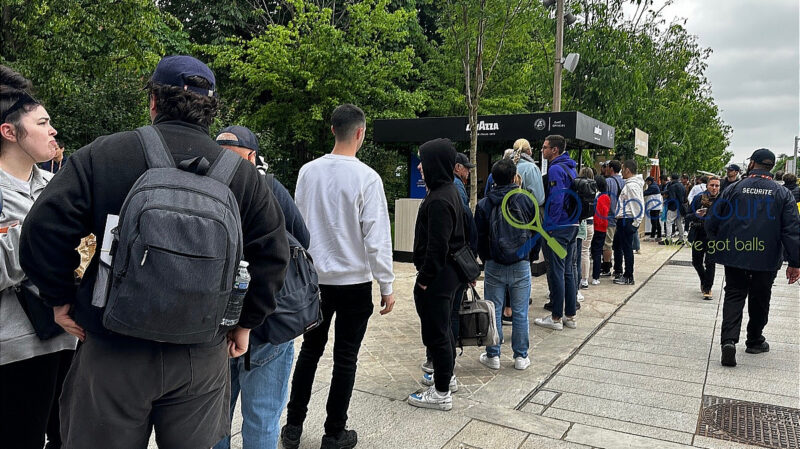
Now, the National Tennis Center will host a full house on the first Sunday. Except, of course, that the fans won’t get the same value as they did before, even if the prices will probably go up again this year.
The first round being split over three days means fewer quality players on the slate each day – and that has, in the brief history of this phenomenon, been especially true on the “first Sundays”.
There are fewer match courts in use, fewer matches overall. There also have been fewer concessions available for food and drink. Which results in long queues everywhere.
And for those who don’t have access to Arthur Ashe or Louis Armstrong Stadiums, that means longer queues for the other show courts that offer non-ticketed seating.
The AO comparison
The customer experience at the Australian Open the last two years (this year, the first Sunday was curtailed by rain, which made for even less value for the fans who paid the price) has been that you basically can’t breathe on the site that first day.
In the late afternoon, with day-sessioners still on hand and the night-session people flowing in, it’s legitimately claustrophobic every day. The AO also sells “evening session grounds passes”.
The queues everywhere – for the show courts, for a coffee or a beer or an overpriced steak sandwich – were endless. But of course the prices didn’t go down.
As a short-term money grab, no doubt it makes sense to the tournaments – especially the Australian Open, which took a huge financial hit to continue to hold the tournament during the worst of the pandemic.
But we speak to a lot of fans on the grounds as we blanket the site during the qualifying, and even in those early days of the main event. And the overwhelming feedback is that the prices keep going up every year, the site becomes more unnavigable every year, and it’s slowly but surely pricing itself out of reach for the average fan.
If a tournament thinks it can keep pushing the envelope every year only with the slice of casual, high-income fans willing to pay whatever price they charge, good on them. So far, they’ve been proven right. But it feels as though there has to be a ceiling there. And it remains to be seen what the long-term effects will be, in terms of building the fan base for the future.
And, it remains to be seen whether those who pay a lot of money to attend – only to pretty much queue all day for everything – will find their experience satisfying enough to return year after year.
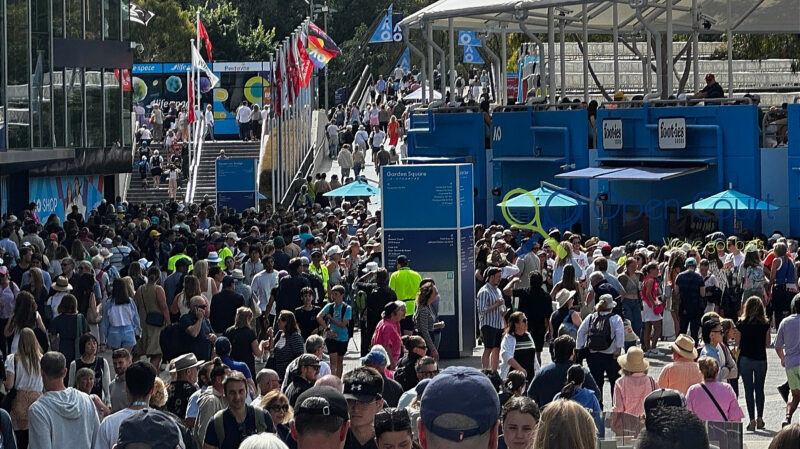
The “million-fan mark”
With the addition of the extra day, and of the qualifying week numbers, the Australian Open has boasted going over the “one million fan mark” at its tournament the last two years.
The final tally at the 2024 US Open – including those non-paying qualifying fans – was 1,048,669, an 8% increase over 2023.
This surpassed the 1,020,763 the Australian Open boasted earlier in 2024 as the first to get there (although with the qualifying, that number was 1,110,657).
Last month, the AO attendance was up to 1,218,831. The tournament has installed CCTV technology that ensures they don’t have to pause grounds pass sales because they can more accurately judge where (at least in theory, if not in practice), the site has “available capacity”. That’s not the fan experience on the ground, though. There is no available capacity even as people keep coming in.
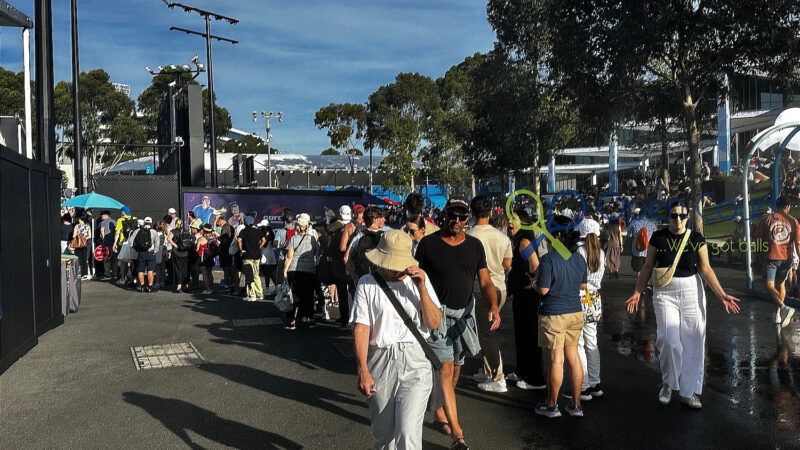
Those attendance numbers are great. Ka-ching. The downside is that the more people you stuff through the doors, the smaller the percentage of knowledgeable tennis fans becomes. And the tournaments have seen increasing instances of poor fan behaviour. Some of that is due to the fact that it just seems to be what too many sports fans are becoming. But the lack of knowledge of the sport certainly contributes.

The recent change in policy to let fans into the courts after every game has also contributed to the chaos in the stands, all match long. This doesn’t affect the players THAT much – there are moments where they have to wait, but generally players are just getting on with it. But it does have a major effect on the fan experience in the stands.
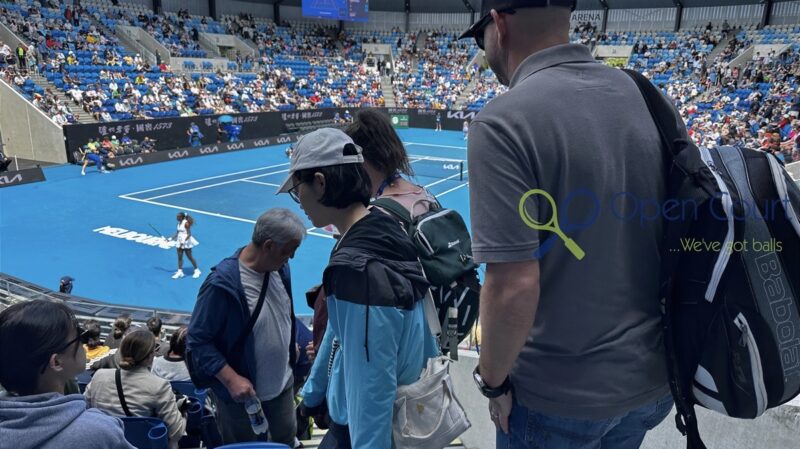
Imagine you settle in to watch a match. You’ve got your snacks sorted. You’re sitting on the aisle. But every single time a game ends, you have to get up to let people get through to sit, and get up let people out any old time. Three minutes later, same thing. Three minutes after that, same thing again. And so on, and so on.
While the casuals are oblivious, or don’t care, you’re downgrading the experience for your core base of fans.
Where will it end? Whenever the money stops flowing, we’re guessing.

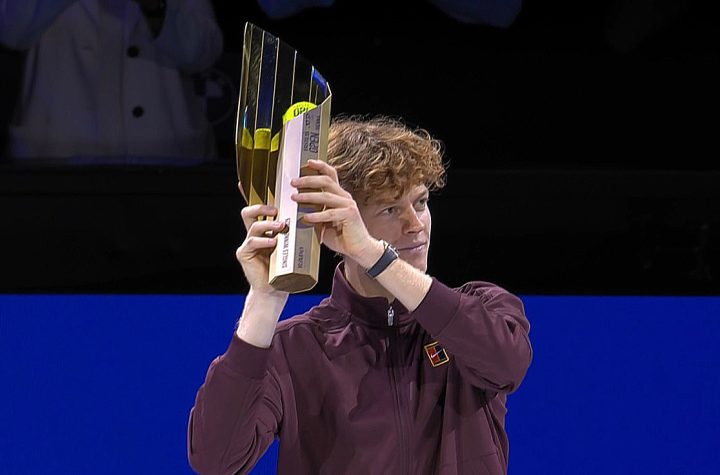
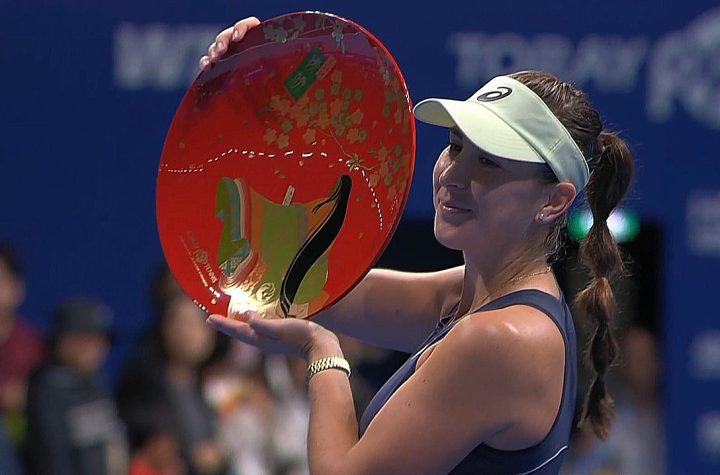

Not just Slams. I was thinking of going to the UTS format in Guadalajara this weekend because Shapo was scheduled to play. The cheapest ticket is $291 CDN at today’s exchange rate. Good thing I couldn’t afford it because Shapo pulled out.
I have been lucky enough to go to Slams in my life, & they were awesome experiences. I went to the US Open when it was played at Flushing Meadows, & to the Australian Open in the early 2000s. At the time they were affordable (tickets, souvenirs, etc.), & we didn’t need to lineup for anything (or, not much). There was no wall to wall people. It was thoroughly enjoyable. I’m glad I got to experience the Slams then, because I will never be able to afford to go to another. The crowds would be extremely off-putting, too.
The grounds passes are still a relatively good deal, especially the first week.
And the way it’s morphing into a three-week event, there’s still value in that first week.
Other than lining up everywhere.
But exhibitions can charge whatever the market will bear. I mean, it’s a separate category. They have sunk costs in having to mount the entire thing for a day or two, and take it down, among other issues.
I see the tickets for Saturday, for example, that are the equivalent of $42 or $84 CAD
So I’m not sure where you were looking.
The Sunday finals are more, of course.
Nothing at “$291 the cheapest). Even the most expensive on Sunday are about $200 CAD.
Saw the prices on this website: https://www.sopitas.com/deportes/uts-guadalajara-2025-fecha-tenistas-confirmados-boletos-centro-panamericano-zapopan/
Also, my senior brain was not functioning properly when I wrote that I went to the US Open at Flushing Meadows. I went when it was at Forest Hills.
I mean, probably best to go directly to the tournament website.
Thanks for all of this information Steph. As hard core fans who have been involved in tennis for 45 years, we also decry the hyper monetization of our sport. Yet it’s happening in all the major sports; as you say ka-ching. We miss the quality fan experience as we relax in front of our tv. Please keep up your great reporting!
I don’t have anything against making money per se. But it’s shortsighted to go for these extreme cash grabs. Because people aren’t stupid.
And tennis is one of the few sports (hockey is another) whose revenue is FAR more dependant on bums in seats than, say, the NFL or a league that gets HUGE TV bucks.